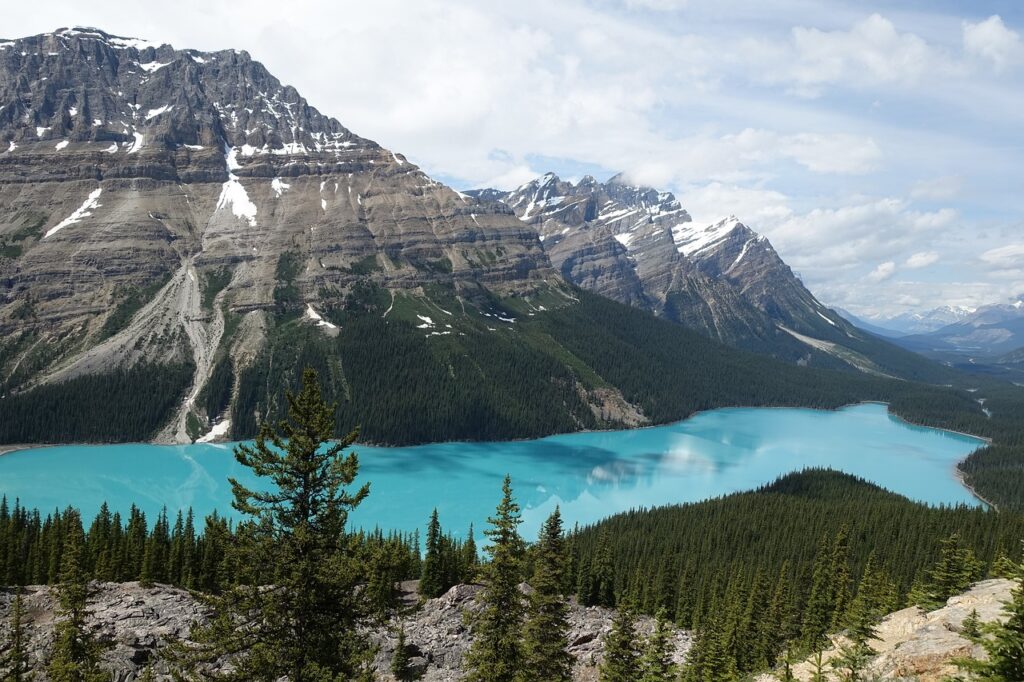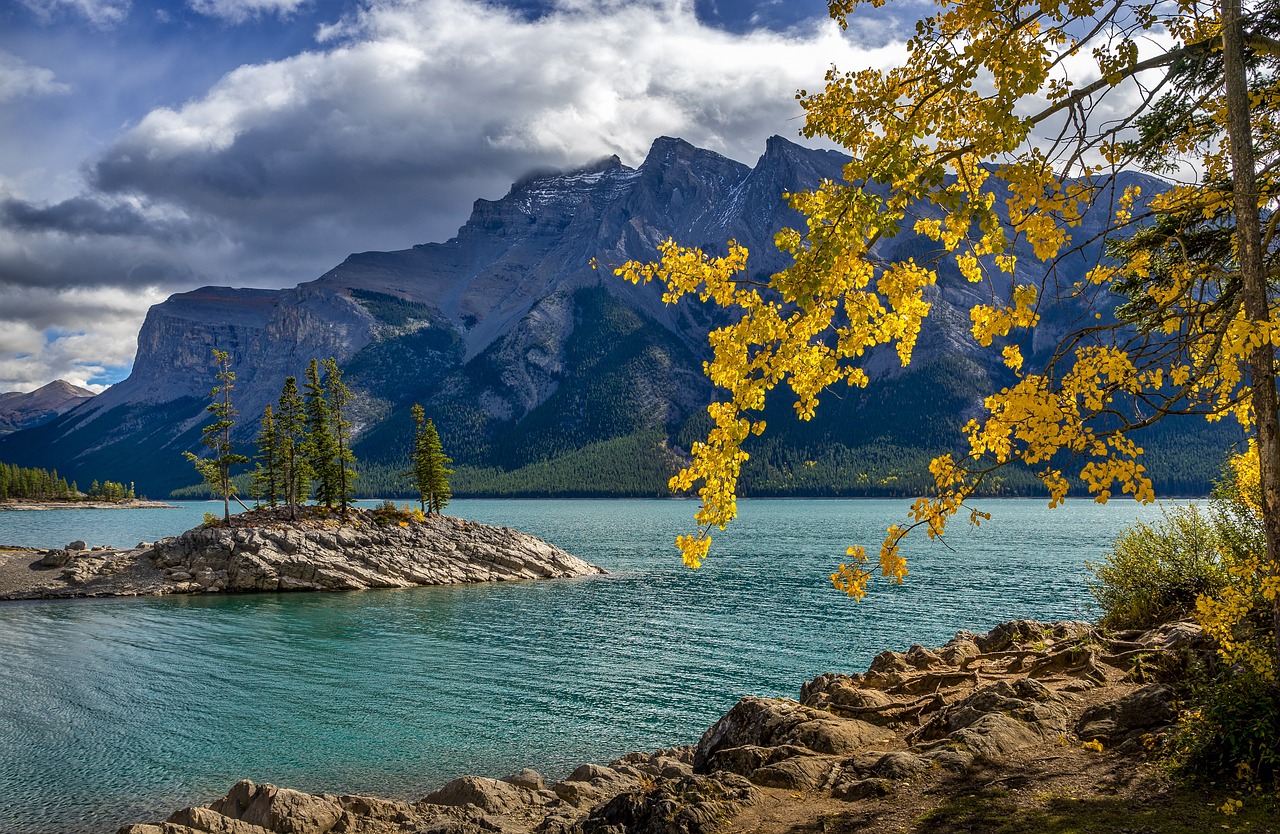Exploring Banff National Park Alberta: Your Guide to the Canadian Rockies
The sheer grandeur of the Canadian Rockies is almost unbelievable – those mountains in the Banff national park Alberta and lakes burst with vibrant, surreal colors. Banff National Park, amid these dramatic landscapes, stands out as one of the planet’s most frequented parks, and rightfully so.
What makes this place legendary isn’t just the stunning photos that have flooded the internet. It’s also because this beauty isn’t confined to extreme hikers. Accessible? Absolutely. If you can handle a 30-minute uphill walk and navigate decently on wheels, you’re in for a treat.
A Scenic Marvel
Banff National Park isn’t just a feast for the eyes; it’s a realm with diverse accommodation options – from cozy cabins and hostels to luxurious 5-star hotels. Campgrounds? They’ve got those too, perfect for those inclined to gather around a crackling campfire. Plus, the local infrastructure is top-notch – good roads, manageable parking (more on that soon), and all the amenities you’d need, conveniently close regardless of where you are in the parks. In terms of travel ease, it surpasses the challenges of places like Patagonia in South America.
Planning Your Stay
Ah, Banff – a name that echoed in my childhood memories, tales of its beauty shared at family gatherings. And this summer, I finally made the pilgrimage. It’s been a dream for my mom, long before I was old enough to drive.
But let’s talk logistics. Banff is a magnet for tourists worldwide. You’ll hear tongues from every corner and perhaps a few unfamiliar ones. But be warned, July and August bring crowds; it’s peak season, and you’ll witness the glacial lakes in their fullest glory.
Lakes, Lakes, Lakes
And let’s be real – the lakes steal the show. If you’re in for the mesmerizing turquoise waters, you’re in the right place.
Where to Settle
Surprisingly, I wouldn’t suggest staying in Banff or Canmore. Why? Because the must-see lakes are further north, resulting in more time behind the wheel. We didn’t even swing by Banff town; there are attractions, sure, but that’s not the main event.
My recommendation? Lake Louise. It’s smack in the middle of all the spots you’re itching to visit. Accommodations vary; the Fairmont Chateau Lake Louise stands regally by the lake, a bit lavish but oh-so-perfect. For a more budget-friendly stay, consider the Mountaineer Lodge or HI Lake Louise Alpine Centre.

Best lakes to visit:
1) Lake Louise:
This lake epitomizes Banff’s beauty, so it’s a must-see. Luckily, no hike is needed to reach it, but parking can be a challenge. To catch the serene sunrise and the mirror-like water, aim to arrive around 6 AM. Along the lake’s right side, a trail leads to a peaceful hike up the mountain, offering breathtaking vistas. Canoeing here is a fantastic experience, albeit a pricey one. Opt for a late afternoon slot (around 8 PM) to possibly have the lake all to yourselves for a few magical moments. To secure a canoe, contact the Fairmont Lake Louise concierge; the experience, though a splurge at around $100 CAD for two people, is undoubtedly worth it.
2) Moraine Lake:
Another iconic spot, Moraine Lake demands an early start due to severely limited parking. Arriving by 5:15 AM snagged one of the last legal parking spots, but witnessing the sunrise over the mountains makes it all worth it. The sunrise casts a mesmerizing glow that diminishes as the day progresses. Follow the “Rockpile” trail for the iconic photo spot, then explore the lake’s side trail near Moraine Lake Lodge for varied angles. Early morning strolls by the lake are serene. Canoeing is an option here too, but exact rental details might require inquiry. Key tip: Early arrival is non-negotiable for the best experience!
3) Peyto Lake and Bow Lake:
These neighboring lakes on the Icefields Parkway, merely five minutes apart, boast breathtaking beauty with easy access. Plan an early visit, preferably before 8 AM. Start with Peyto Lake, known for its fox-head shape and sweeping vistas, but be aware that it’s a favorite spot for Instagram models and influencers practicing yoga (or pretending to). The short, steep climb is worth the view. Bow Lake, nearby, offers easy access and stunning photo opportunities without any uphill hikes.
4) Johnston Canyon:
Embark on a picturesque hike along Johnston Canyon, a trail that winds through a canyon offering views of two stunning waterfalls. What makes this hike exceptional is that parts of the trail cling to the canyon’s side with sturdy railings, immersing you deep within the heart of the Rockies.
Parking here typically requires a fee, but a nifty tip: after 6 PM, the fee is waived. We opted for an evening hike around 6 PM, and while there were still a few fellow explorers on the trail, the crowds had significantly dwindled. During peak daytime hours, this trail can resemble a long queue of hikers, so I highly recommend the late afternoon for a more peaceful experience. It’s a great way to immerse yourself in the natural beauty without feeling crowded.

Yoho National Park:
Often overlooked but brimming with breathtaking beauty, Yoho National Park, nestled in British Columbia, offers some of the Rockies’ most captivating sights. Conveniently close to Banff, particularly if you’re staying near Lake Louise, Yoho is a delightful day trip, especially during the less-crowded months of July and August.
1) Emerald Lake:
A personal favorite, Emerald Lake unveils its true magic in the morning tranquility. Aim to arrive around 7:30 AM to relish the serenity; at that hour, you’ll likely have the entire place to yourself. Wander along the lake’s perimeter, reveling in the captivating views and mirror-like reflections. The trail, mostly flat and winding through lush forests, offers a peaceful stroll. Parking isn’t an issue if you’re an early bird, but by 9 AM, tourists start flocking in, though many don’t venture around the entire lake.
2) Lake O’Hara:
While I didn’t personally visit, the beauty of Lake O’Hara is evident with a simple Google search. It’s a hidden gem, far off the beaten path. However, reaching it requires a 14km hike (the reason we missed it), which I’d undoubtedly consider next time. Access is limited, with only two daily buses that need to be reserved well in advance. Information on bus reservations can be found on their website.
3) Takakkaw Falls:
Accessible and frequented by families, Takakkaw Falls boasts powerful waters amidst stunning surroundings. If you’re in the vicinity or traveling with kids, this spot is a must-visit. Despite the family crowds, the natural beauty and the sheer force of the falls make it a worthwhile stop.
Jasper National Park:
Apart from the Banff National Park in alberta, Nestled north of Banff, Jasper beckons with a more relaxed atmosphere, a welcome change from the bustling crowds. The drive from Lake Louise along the Icefields Parkway (93) spans around three hours, an enchanting route laden with captivating stops. But beware: gas stations are sparse along this road, so ensure a full tank before embarking, especially considering the steep inclines.

Where to Stay:
Unlike Banff, Jasper town conveniently situates you near the park’s attractions. Accommodations vary, but the Alpine Village Jasper offers simplicity just six minutes’ drive from town.
Most Beautiful Places:
1) Maligne Lake and Spirit Island:
The panoramic view of Spirit Island remains an iconic gem in the Canadian Rockies, made famous by a 1960s photography exposition. To reach Spirit Island, choose between a challenging 14km canoe/kayak trip (recommended for seasoned rowers) or opt for the Maligne Lake Cruise. Booking tickets in advance, especially during peak season, is crucial. Late afternoons are ideal for this serene journey.
2) Valley of the Five Lakes:
Embark on a hike unveiling five distinct lakes—each a spectacle of vibrant greens and turquoise hues. These vivid waters might be the origins of Jasper’s name. Noticeably different from Banff’s glacial waters, these lakes offer striking colors and exceptional clarity.
3) Medicine Lake:
Dubbed a “disappearing lake,” Medicine Lake showcases its full splendor in summer, particularly in July and August. Although there isn’t a defined path around it, the reflective beauty of this lake warrants a stop, especially en route to Maligne Lake.
4) Sunwapta Falls:
This dramatic, diamond-shaped waterfall landscape is a sought-after capture in Jasper. The path from the parking lot is straightforward, leading to a bridge where many capture photos. Venture off the beaten path, if cautious, to seize a frontal view of the falls. But tread carefully and be respectful of the wildlife.
General Travel Tips:
1) Crowd Avoidance Strategies:
Banff gets overwhelmingly crowded from June to September, especially between 8 AM and 5 PM. Opt for early starts (around 5 AM) or late outings (until 9 PM) to beat the crowds. Most attractions remain accessible 24/7, offering lighter foot traffic during off-peak hours. It might be a bit tiring, but the experience is more serene and worth the effort.
2) Wildlife Awareness:
The Banff National Park in Alberta is a popular spot and is generally crowded and safe, remote hikes warrant extra precautions. Equip yourself with bear spray and know-how to use it, hike in groups, and make noise to alert wildlife. Feeding or getting too close to wildlife poses risks for both humans and animals and should be avoided at all costs.

3) Renting a Car and Parking:
Renting a car, preferably a 4-wheel drive, is advisable for exploring the region. Expect considerable driving, and adhere to speed limits and signage. Parking can be challenging, especially after 8 AM or before 6 PM. In some areas, parking along roads is acceptable, but ensure safety. Moraine Lake restricts access when parking fills up or if illegal parking occurs, risking towing.
4) Food and Water Preparation:
Restaurants are limited outside towns and hotels, so bring along food if you plan on spending the day exploring. While not gourmet, the packed food will sustain you during your adventures. Additionally, food prices can be steep, so planning ahead can save both money and hunger pangs.
5) Download Offline Maps:
Local infrastructure limitations in Banff National Park Alberta might affect data and Wi-Fi connectivity, especially along routes like the Icefields Parkway. Prepare by downloading offline maps through apps like Google Maps each day before your expeditions. This ensures you always have a reliable reference point, even without internet access.
These tips should help optimize your experience while exploring Banff and the surrounding areas! Let me know if there’s anything else you’d like to know or if you need further details on any point.
Read also: https://growbywill.com/niagara-falls-guide-2024/

[…] Read also: https://growbywill.com/banff-national-park-alberta/ […]